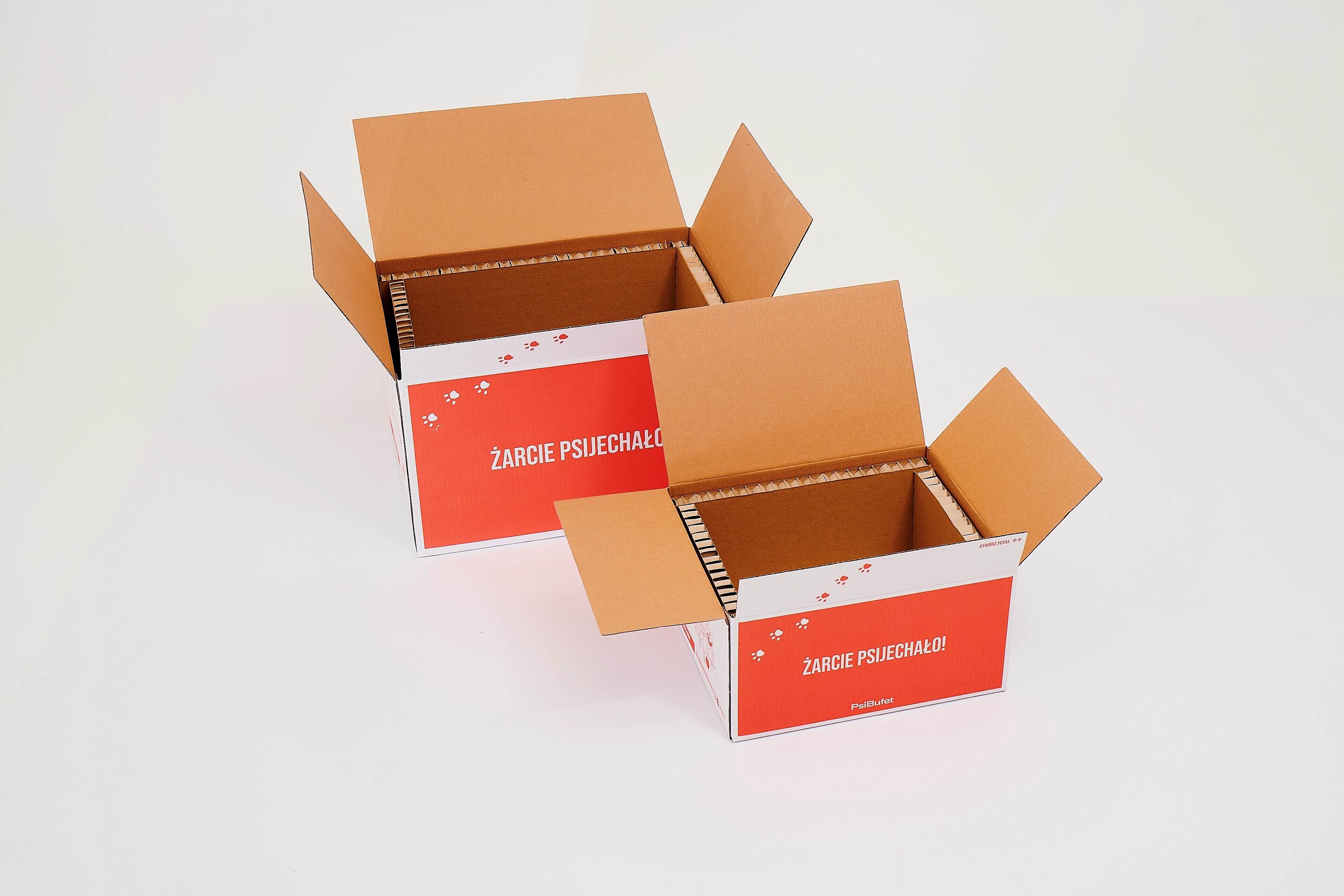How Packhelp developed thermal packaging for food delivery – PsiBufet Case Study


Subscribe now! Receive 15% discount.
Don’t miss out – get 15% off your first order when you join the newsletter. It’s fast, free, and kinda smart.
You're now subscribed!
In this article:
Over the last six months, Packhelp delved into an R&D project with PsiBufet. The result was an innovative cardboard box that can be used to deliver frozen dog food. The boxes are fully sustainable and cost-effective in comparison to existing packaging solutions.
PsiBufet approached Packhelp with the challenging project of designing sustainable packaging for frozen food delivery. Through a series of prototypes, development, testing, and cost-optimizing, Packhelp's packaging engineers were able to deliver a unique solution which outperformed any other available product.
The tailor-made box keeps the temperature below 0 degrees Celcius for 24 hrs, while also being sustainably-made and 67% cheaper than existing alternatives.

The growth of the Polish dog food market, now with an estimated value of 675 million EUR, creates opportunities for the packaging market too. PsiBufet, is a new but pioneering name in the Polish dog food industry.
When PsiBufet got in touch with Packhelp, the company had not yet launched, but their mission was to revolutionize the dog food industry by providing pet owners with nutritional, high-quality food, already prepared and ready to serve.
Veterinarians and canine dieticians all had input in developing recipes set to deliver a new, better quality product to the market.
“At PsiBufet we aim to enhance dog health by providing individually tailored dog food made from top-quality ingredients at a reasonable price.”
PsiBufet’s business model is based on regular deliveries, on a subscription basis. Customers receive their package every two to four weeks.
In every first order, PsiBufet includes all of its products, so that the doggo can taste the entire range. The specific diet is adjusted after that test run.

R&D process of Thermo Box for food, made from cardboard and honeycomb walls
The project for PsiBufet was developed as part of the Packhelp Lab, where packaging experts deliver innovative solutions and optimize existing packaging designs in terms of costs, materials and many more aspects.
You can get in touch with our team too. Send us your packaging brief here.
During the discovery phase, the Lab team manually tested many types of packaging materials and designs to understand the strengths and weaknesses of each solution.
The initial brief required similar properties to styrofoam, however also needed to be eco-friendly at the same time.
Among the tested materials were:
- styrofoam,
- plastic containers and bags,
- organic wool
- corrugated cardboard
- paperboard
To conclude the discovery phase of the project, Packhelp's Lab experts prepared several concepts to discuss with PsiBufet.
After the feedback round, the possibilities were narrowed down to corrugated cardboard as the go-to shipping material. The challenge now was to meet the temperature isolation requirement.
Extensive research created several concepts, such as organic material woolcool, and corn-based foam.
Woolcool was expensive and increased the convection time as it requires manual wrapping of each frozen can. Corn-based foam, on the other hand, was still above the budgetary constraint, however, the convection time was optimized.
The team arrived at another solution - honeycomb walls. After constructing the box and isolating the products inside, the manual tests provided promising results.
The graph below shows the results of tests made with a thermometer placed inside the tested food product.

Tests were also made with a thermometer used outside the product. Cardboard boxes kept the product cool for the initial 24 hour period, with a gradual increase of temperature over time.
Over the next 24 hrs, the box kept a steady temperature of 0 C. In order to prevent the product from expiring, the boxes had to maintain the thermal isolation effect over at least 24 hours.
Note: Product samples and the packaging design were tested in controlled circumstances. There are numerous factors that contribute to and slightly affect the results.
As part of the project, Packhelp also developed visuals for the PsiBufet. The 3D renders helped explain the concept, allowing the teams to discuss the details of the design as well as the printed artwork.
Get in touch with us - send us a brief for your custom packaging.

How Packhelp reduced the costs of packaging & made the boxes easy on the environment
Many packaging products on the market can only be disposed of in landfill. Plastic cooling bags can’t be easily recycled, but many brands choose them simply because they're the cheapest option available.
As mentioned before, PsiBufet considered cooling boxes made from styrofoam; however, styrofoam boxes with the required thermal insulation properties are significantly larger and therefore cost more to send to the end customer. Not to mention styrofoam is a petroleum-based product and detrimental to the environment.
Other sustainable materials - such as boxes with wool used to isolate the temperature - were too costly.
The Thermo boxes designed for PsiBufet are made from 100% recycled contents, along with the organic honeycomb walls.
Contrary to popular plastic products, cardboard is easily recyclable. Cardboard & honeycomb proved to deliver longer-lasting results in terms of thermal performance, too.
As a consequence, the R&D process helped create a cutting-edge solution for food deliveries that’s eco-friendly too.
Do you need help with developing a new packaging design for you? Describe your needs here.

Costs optimization
During testing, the Packhelp Lab team estimated the price unit of several concepts.
One of the ideas was to use thinner cardboard boxes and use wool as the thermal-control medium. However, this largely increased time that the pouches were kept cool. This solution would also need additional fillers in the form of wool that had to wrap each food pouch individually.
A thicker type of corrugated cardboard (flute B) worked better for shipping. Thanks to a better fit between the packaging and the product, there was no need for additional fillers. Therefore, the costs were reduced by 67% in comparison to existing solutions.
 Final thoughts
Final thoughts
The packaging R&D process allowed the company to implement a cutting-edge solution, which outperforms other products on the market. The business model of PsiBufet required an entirely different approach. Through a series of manual testing, prototyping and with collaborative work, Packhelp and PsiBufet managed to create a thermal cardboard box that exceeds the initial brief.
The final results of the collaboration were:
- Two box sizes, large (37.0 x 327.0 x 257.0 mm) and small (327.0 x 267.0 x 167.0 mm)
- Boxes were made of 100% recycled cardboard, without any plastic or costly cooling materials
- Price per unit was 67% lower than other solutions
This type of packaging can be designed to match other products too. If you need thermally insulated packaging for your business - or any tailor-made packaging design - contact us.
Learn more about Packhelp's range of products. Visit our shop.









